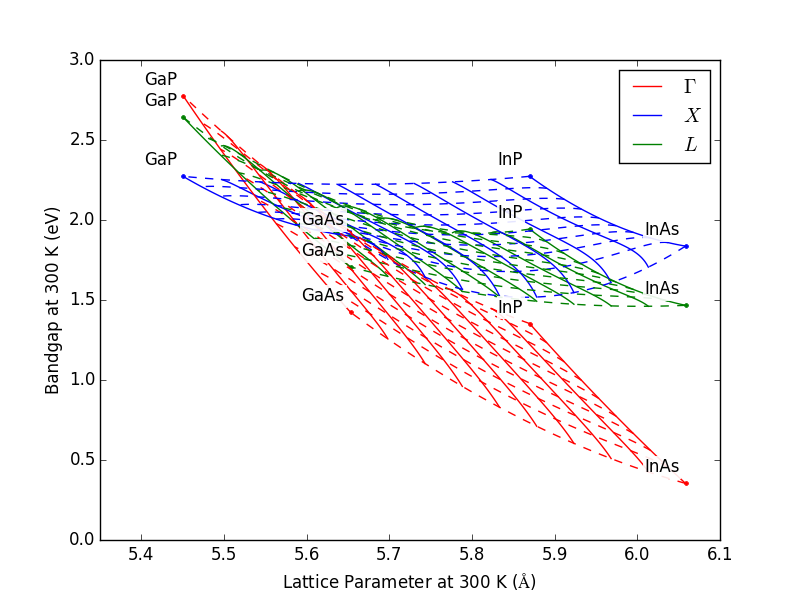Plot Bandgap vs Lattice Constant of Quaternary3¶
Source:
#
# Copyright (c) 2013-2014, Scott J Maddox
#
# This file is part of openbandparams.
#
# openbandparams is free software: you can redistribute it and/or modify
# it under the terms of the GNU Affero General Public License as published
# by the Free Software Foundation, either version 3 of the License, or
# (at your option) any later version.
#
# openbandparams is distributed in the hope that it will be useful,
# but WITHOUT ANY WARRANTY; without even the implied warranty of
# MERCHANTABILITY or FITNESS FOR A PARTICULAR PURPOSE. See the
# GNU Affero General Public License for more details.
#
# You should have received a copy of the GNU Affero General Public License
# along with openbandparams. If not, see <http://www.gnu.org/licenses/>.
#
#############################################################################
# Make sure we import the local openbandparams version
import os
import sys
sys.path.insert(0,
os.path.abspath(os.path.join(os.path.dirname(__file__), '../..')))
from openbandparams import *
import matplotlib.pyplot as plt
import numpy
quaternary = GaInPAs
T = 300
# initialize the plot
fig = plt.figure()
ax = fig.add_subplot(111)
plt.xlabel('Lattice Parameter at %g K ($\AA$)' % T)
plt.ylabel('Bandgap at %g K (eV)' % T)
# plot the binaries
xs = []
y_Gamma = []
y_X = []
y_L = []
labels = []
for b in quaternary.binaries:
xs.append(b.a(T=T))
y_Gamma.append(b.Eg_Gamma(T=T))
y_X.append(b.Eg_X(T=T))
y_L.append(b.Eg_L(T=T))
labels.append(b.name)
ax.plot(xs, y_Gamma, 'r.')
ax.plot(xs, y_X, 'b.')
ax.plot(xs, y_L, 'g.')
# label the binaries
for x, y, label in zip(xs, y_Gamma, labels):
ax.annotate(label, xy=(x, y), xytext=(-5, 5), ha='right', va='bottom',
bbox=dict(linewidth=0, fc='white', alpha=0.9),
textcoords='offset points')
for x, y, label in zip(xs, y_X, labels):
ax.annotate(label, xy=(x, y), xytext=(-5, 5), ha='right', va='bottom',
bbox=dict(linewidth=0, fc='white', alpha=0.9),
textcoords='offset points')
for x, y, label in zip(xs, y_L, labels):
ax.annotate(label, xy=(x, y), xytext=(-5, 5), ha='right', va='bottom',
bbox=dict(linewidth=0, fc='white', alpha=0.9),
textcoords='offset points')
# plot the quaternary
indices = numpy.arange(100)
fractions = numpy.linspace(0, 1, 100)
x = numpy.empty(100, dtype=numpy.float)
y_Gamma = numpy.empty(100, dtype=numpy.float)
y_X = numpy.empty(100, dtype=numpy.float)
y_L = numpy.empty(100, dtype=numpy.float)
first = True
for xfrac in numpy.linspace(0, 1, 10):
for i, yfrac in zip(indices, fractions):
instance = quaternary(x=xfrac, y=yfrac)
x[i] = instance.a(T=T)
y_Gamma[i] = instance.Eg_Gamma(T=T)
y_X[i] = instance.Eg_X(T=T)
y_L[i] = instance.Eg_L(T=T)
if first:
ax.plot(x, y_Gamma, 'r-', label='$\Gamma$')
ax.plot(x, y_X, 'b-', label='$X$')
ax.plot(x, y_L, 'g-', label='$L$')
first = False
else:
ax.plot(x, y_Gamma, 'r-')
ax.plot(x, y_X, 'b-')
ax.plot(x, y_L, 'g-')
for yfrac in numpy.linspace(0, 1, 10):
for i, xfrac in zip(indices, fractions):
instance = quaternary(x=xfrac, y=yfrac)
x[i] = instance.a(T=T)
y_Gamma[i] = instance.Eg_Gamma(T=T)
y_X[i] = instance.Eg_X(T=T)
y_L[i] = instance.Eg_L(T=T)
ax.plot(x, y_Gamma, 'r--')
ax.plot(x, y_X, 'b--')
ax.plot(x, y_L, 'g--')
xmin, xmax = plt.xlim()
plt.xlim(xmin - 0.05, xmax)
plt.legend(loc='best')
if __name__ == '__main__':
import sys
if len(sys.argv) > 1:
output_filename = sys.argv[1]
plt.savefig(output_filename)
else:
plt.show()
Result:
